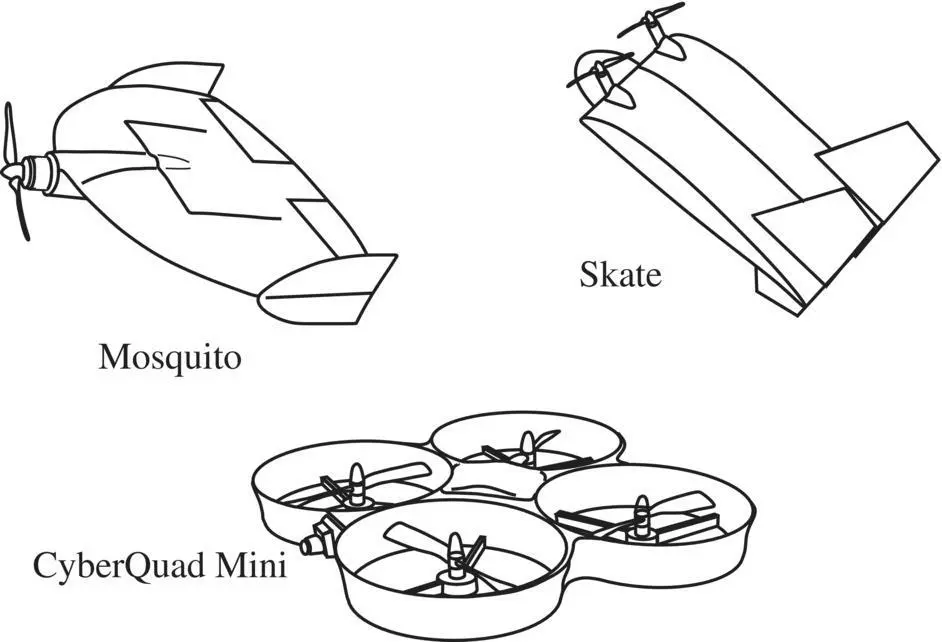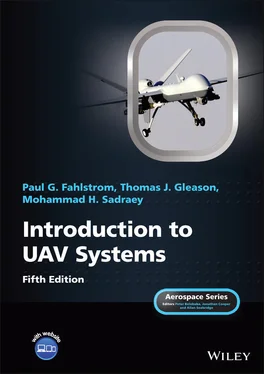The realm of small UAVs is one in which there is no competition from manned vehicles. It is unique to vehicles that take advantage of the micro‐miniaturization of sensors and electronics to allow humans to view the world from a flying vehicle that could land and take off from the palm of their hand and can go places that are not accessible to anything on a human scale.
The motivation for larger UAVs is to provide long endurance at high altitudes with the ability to fly long distances from a base and then loiter over an area for many hours using a larger array of sensors to search for something or keep watch over some area. Increasingly, in the military arena, the larger UAVs also provide a capability to carry a large weapons payload a long distance and then deliver it to the destination area.
There now is increasing talk about performing missions such as heavy air transportation, bombers, and even passenger transportation with unmanned systems. Whatever may be the outcome of those discussions, it is likely that there eventually will be unmanned systems of all sizes.
In the following sections, we use intuitive‐size classes that are not in any sense standardized but are convenient for this discussion. In the next six sections, general features of micro, mini, very small, small, medium, and large UAVs are presented.
A new class of UAVs called micro‐UAVs is of growing interest, which have the attributes of large insects and very small birds. This is a term for a class of UAVs that are, as of this writing, still largely in the conceptual or early stages of development. They are envisioned to range in size from a large insect to a model airplane with a one‐inch wingspan. The advent of the micro‐UAV produces a whole new series of challenges associated with scale factors, particularly micro‐autopilot and control in atmospheric phenomena such as wind and gust.
Although there are still no active micro‐UAVs in existence, DARPA have attempted a program to develop micro‐UAVs including a flapping wing. The world’s smallest and lightest micro‐helicopter UAV was experimented and demonstrated by Japanese Epson Corporation – with a prop diameter of 130 mm and a mass of 8.9 g. Insight into the art of bird‐size UAVs may be obtained from Hank Tennekes’ book, The Simple Science of Flight from Insects to Jumbo Jets [7].
Assuming that payload and power‐plant problems can be solved, the low wing loading of these types of air vehicles may prohibit operation in all except the most benign environmental conditions (e.g., no wind). Some of these problems, and solutions, will be discussed in Part Two of this book.
This category stems from the old expendable definition and includes hand‐launched as well as small UAVs that have some type of launcher (could be hand‐launched). It is not officially defined by the JPO as a class of UAVs, but numerous demonstrations and experiments have been conducted over the past ten years.
These UAVs are exemplified by the electric‐powered Raven and Bayraktar mini‐UAVs in the selection of UAV examples earlier in this chapter. The Wasp UAV described among the previous examples is another example of a UAV at the upper limit of what might be called a “mini”‐UAV. The ANAFI Parrot can be considered as a mini‐UAV where it has a mass of about 0.5 kg, equipped with two 4K 21‐megapixel cameras, and can fly for about 32 minutes.
Another example for this class is the HR quadcopter, which has four electric engines, dimensions of 7.1 in × 6.7 in × 1.5 in, and a takeoff mass/weight of about 120 g (4.23 oz). It is equipped with a 1080P HD Camera and can take aerial photos/videos, with the built‐in WiFi module to broadcast a live video on a mobile device.
For the purposes of this discussion, “very small UAVs” range from “micro” sized, which are about the size of a large insect, up to an AV with dimensions of the order of a 30–50 cm (12–20 in). There are two major types of small UAVs. One type uses flapping wings to fly like an insect or a bird and the other one uses a more or less conventional aircraft configuration, usually rotary wing for the micro size range. The choice of flapping wings or rotary wings often is influenced by the desire to be able to hover and land/perch on small surfaces to allow surveillance to continue without having to expend the energy to hover. Another advantage of flapping wings is covertness, as the UAV may look a lot like a bird or insect and be able to fly around very close to the subjects of its surveillance or perch in plan‐view without giving away the fact that it is actually a sensor platform.
At the small end of this range and for flapping wings, there are many special issues related to the aerodynamics that allow the small UAVs to fly. However, in all cases the basic aerodynamic principles and equations apply, and one needs to understand them before proceeding to the special conditions related to very small size or flapping wings. Part Two of this book introduces the basic aerodynamics and some discussion to the issues for small size and flapping wings.
Examples of very small UAVs include the Chinese DJI mini 2, which is a quadcopter that can hover (i.e., vertically takeoff and land); the Israeli IAI Malat Mosquito, which is an oval flying wing with a single tractor propeller; the US Aurora Flight Sciences Skate, which is a rectangular flying wing with twin tractor engine/propeller combinations that can be tilted to provide “thrust vectoring” for control; and the Australian Cyber Technology CyberQuad Mini, which has four ducted fans in a square arrangement.
The Mosquito wing/fuselage is 35 cm (14.8 in) long and 35 cm (14.8 in) in total span. It uses an electric motor with batteries and has an endurance of 40 minutes, and claims a radius of action of about 1.2 km (0.75 mile). It is hand or bungee launched and can deploy a parachute for recovery.
The DJI Phantom 4 Pro quadcopter has four electric engines, dimensions of 9.9 in × 15.7 in × 6.75 in, and a takeoff weight of about 3 lb. It is equipped with an electro‐optic camera and autopilot that allows fully autonomous waypoint navigation. It can be controlled via a smart phone as a ground control station using a Wi‐Fi connection, by which the live videos are received.
The Skate wing/fuselage has a wingspan of about 60 cm (24 in) and length of 33 cm (13 in). It folds in half along its centerline for transport and storage. It has twin electric motors on the leading edge that can be tilted up or down and allow vertical takeoff and landing (VTOL) and transition to efficient horizontal flight. There are no control surfaces, with all control being accomplished by tilting the motor/propeller assemblies and controlling the speed of the two propellers. It can carry a payload of 227 g (8 oz) with a total takeoff weight of about 1.1 kg (2 lb).
The CyberQuad Mini has four ducted fans, each with a diameter of somewhat less than 20 cm (7.8 in), mounted so that the total outside dimensions that include the fan shrouds are about 42 cm by 42 cm (16.5 in). The total height including the payload and batteries, which are located in a fuselage at the center of the square, is 20 cm (7.8 in).
The CyberQuad Mini includes a low‐light level electro‐optic camera or thermal camera and a control system that allows fully autonomous waypoint navigation. The toy has two onboard cameras, one facing forward and one facing down, and is controlled much like a video game from a portable digital device such as a tablet computer or a smart phone. Drawings of these UAVs are shown in Figure 2.2.

Figure 2.2 Very small UAVs
Читать дальше













